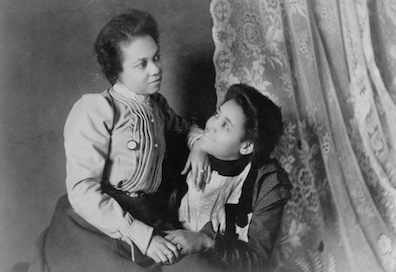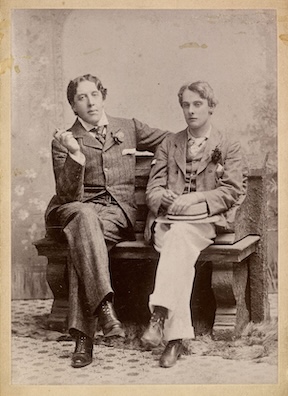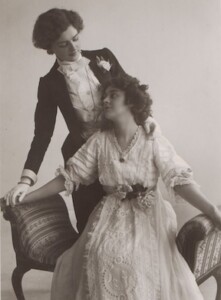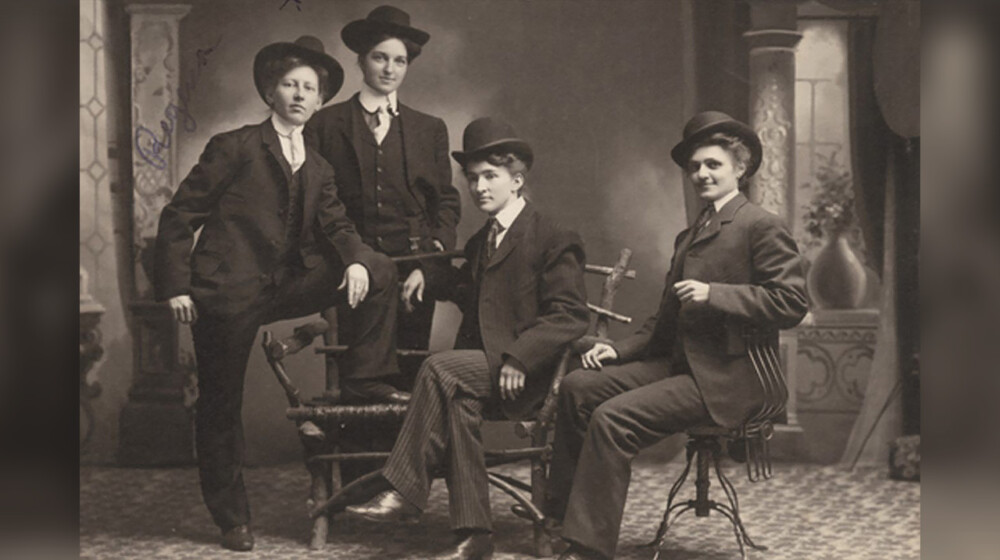“My existence is a scandal.”
– Oscar Wilde
The long history of LGBTQIA+ Identities
Posted June 1, 2024
Written by Noelle Porterfield, Museum Specialist
For a printable version of this article, please click here.
Did you know…
 Humanity has historically been, and always will be, decidedly queer. From Whitman to Dickinson, LGBTQIA+ identities can be found if you look through the right lens. Despite being viewed as a time of intense gender roles and societal standards, the Victorian Era harbored its fair share of queer identities.
Humanity has historically been, and always will be, decidedly queer. From Whitman to Dickinson, LGBTQIA+ identities can be found if you look through the right lens. Despite being viewed as a time of intense gender roles and societal standards, the Victorian Era harbored its fair share of queer identities.
Through the Western lens, the Victorian Era (1837-1901) is said to have been the time period when sexuality was “invented”. Sexology, the study and classification of sexual behaviors emerged in the latter half of the 19th century. It was a pivotal moment for how sex and gender roles were defined, and anyone not identifying as heterosexual were labeled as “deviants”. Sexual behavior began to be tied to identity, and the practice of using the terms “gay” and “lesbian” for those who preferred the same sex became common practice. The term “lesbian”, as we recognize it today, was first used in a book from 1732 titled The Toast, by William King. However, in the mid to late Victorian era, fragments from Sappho’s poetry were rediscovered by members of the Parisian literari, and thus began to be seen as the word to describe WLW (Women Loving Women) relationships. Sappho was an ancient Greek poet from the island of Lesbos, whose name is the origin of many of the terms related to WLW individuals. Oddly, in the Victorian Era, lesbian and bisexual relationships were not illegal like gay relationships were. During this time, women were able to express more of their sexuality through their passionate or even intimate friendships. Many of these passions were expressed in literary works, highlighting “recurring patterns of experiences, from feelings of alienation due to the internalized stigma of same-sex desires, to the euphoria and empowerment of a clandestine queer liaison” ((Ross & Antosa, The British Academy, January 2021). Overall, they tended to have tropes relating to the sea, the darkness, or even a tender kiss. Emily Dickinson and Virginia Woolf were two of those who authored such works. By the end of the 19th century, new terms emerged in the English language as more women received an education and joined professional careers. These individuals were classified as the “New Woman”. Along with that, “Boston Marriage”, defined as two professional women sharing a home, and “Sapphists” joined the dictionary.
THE LABOUCHERE AMENDMENT

Oscar Wilde and Lord Alfred Douglas, courtesy of the British Library.
On the other side of things, where sapphic relationships were somewhat deemed socially acceptable, gay relationships were classified as entirely illegal. In Great Britain, this was due to the Labouchere Amendment of 1885, which classified that any sodomic acts (male homosexual acts) were henceworth criminalized and illegal. This Amendment was not completely lifted in Great Britain until the Sexual Offences Act of 2003 – that’s over a century!
“You cannot do anything against the power of my affection for him…”
One of the most famous figures who was affected by the Labouchere Amendment was none other than Oscar Wilde. He was the author of The Picture of Dorian Gray and lover of late 19th century aesthetics, and was imprisoned in 1895 for crimes of homosexuality. By this time, Wilde had already been married to a woman by the name of Constance Lloyd, and they shared two children together named Cyril and Vyvyan. In 1891, he began a relationship with Lord Alfred Douglas, son of the Marquess of Queensbury, which ultimately led to his arrest four years later. Upon his arrest, he was sentenced to two years of hard labor, which would ultimately lead to his death at the age of 46. You could argue how the poetic intent behind The Picture of Dorian Gray – which discusses the ideas of corruption and hedonism – might have reflected Wilde’s thoughts in the last decade of his life.
THE QUEER FRONTIER
Closer to home, here in what was notoriously the “Wild West”, the idea of rugged individualism helped foster an environment that was generally more accepting of people who didn’t conform to societal “norms,” despite the mythologized and almost exclusive image of cowboys as straight, white men. In this saga, The Leatherstocking Tales (James Fenimore Cooper, 1823), the relationship between two of the main characters seems to “outlaw” the modern conceptions of heterosexuality and masculinity when it comes to the Hollywood cowboy – that of the rugged and fearless actions of idealized manhood. Even though the “lone ranger” image is popular in the media, the historic cowboy actually relied on a partner or partners to survive in the hostile environments of the frontier. With that, male–male relationships were common, and while some were solely intended to relieve… frustration, many were rooted in the same romantic imagery that you would see with a heterosexual couple. For example, in the poem The Lost Pardner, written by Cowboy Poet, Charles Badger Clark writes a lament for the loss of his partner, Al:
“We loved each other in the way men do
And never spoke about it, Al and me,
But we both knowed, and knowin’ it so true
Was more than any woman’s kiss could be.
What is there out beyond the last divide?
Seems like that country must be cold and dim.
He’d miss this sunny range he used to ride,
And he’d miss me, the same as I do him.
It’s no use thinkin’—all I’d think or say
Could never make it clear.
Out that dim trail that only leads one way
He’s gone—and left me here!
The range is empty and the trails are blind,
And I don’t seem but half myself today.
I wait to hear him ridin’ up behind
And feel his knee rub mine the good old way.”
In the days of the Gold Rush, it was treacherous for anyone to travel alone, especially for women. So, many took destiny into their own hands. Charley Parkhurst, a stagecoach driver who rode from San Francisco to Los Angeles, was as daring as they came. Nicknamed “One-Eyed Charley,” it was only upon Parkhurst’s death in 1879 to cancer of the tongue that they discovered Charley was biologically a woman. Spending 30 years in “disguise”, Parkhurst became known for the ability to move passengers and gold safely over important routes between gold-mining posts all along what is now recognized as California. However, “One-Eyed Charley” was nowhere near the only anomaly. Harry Allen worked as a longshoreman, a bronco buster, a barber, and a bartender, and was also one of the most notorious “rabble-rousers”, bootleggers, vagrants, and thieves of the Pacific Northwest. Amongst his “crimes” – he was a transgender man who refused to wear women’s clothing, dressing instead as a cowboy, keeping his hair trimmed and speaking with a deep voice. In a 1908 interview, Allen is quoted:
“I did not like to be a girl; did not feel like a girl, and never did look like a girl. So it seemed impossible to make myself a girl and, sick at heart over the thought that I would be an outcast of the feminine gender, I conceived the idea of making myself a man.”
The Western territories, Arizona included, weren’t necessarily more progressive than the Eastern states, but were more accepting of individualism. This gave people a place where they could live, and get jobs, and carry on with a life they couldn’t otherwise have in the quickly growing East. Further, the concept that people assumed different gender identities for practical reasons is the sole reason as to why there are no records of these individuals who chose to live their life outside of their sex assigned at birth. About this phenomenon, Peter Boag, a queer historian of the American West, says:
“As the frontier closed and the Wild West disappeared, these people who found a life there, found validation there, also disappeared from our history.”
THE GENDER BINARY
Amongst the discussion of societal views on queer relationships and a brief discussion of trans and non-binary individuals in the West, those outside of the gender binary are the least discussed at the highest risk of endangerment. This time period was all about preserving the “classic” gender roles, and if you identified as anything but (socially or biologically), you were at major risk. Unfortunately, this is still true today. In 1906, an individual by the name of Nicolai de Raylan met his untimely demise here in Phoenix, Arizona. Formerly, Nicolai was the secretary of Baron von Schlippenbach, the Russian Consul in Chicago. He was diagnosed with tuberculosis and came here to Phoenix in hopes that the dry air would help with his recovery. Unfortunately, the illness took him, and it was then that it was discovered he was on all accounts biologically female. Despite living his entire life as a man, which he was, he was buried in women’s clothes and given no headstone. Fortunately, though, his story is not quite finished. In November of 2019, with the help of Marshall Shore, project manager for the Arizona LGBT+ History Project, Nicolai de Raylan was given a proper burial at Greenwood Memory Lawn Mortuary & Cemetery here in Phoenix. His gravestone is etched with the the Ralph Waldo Emerson quote:
“To be yourself in a world that is constantly trying to make you something else is the greatest accomplishment.”

English actresses Lily Elsie and Adrienne Augarde, circa 1907.
There is also supposed speculation that Louisa May Alcott, author of Little Women, may have also identified outside of the gender binary. Alcott’s works tended to focus on the “unconventional” young woman; one who defied social conformity, and often rebelled. Jo March, from Little Women, is often thought to be Alcott’s alter ego. Alcott is quoted as saying:
“I have often thought that I may have been a horse before I was Louisa Alcott… Now, I am more than half-persuaded that I am a man’s soul, put by some freak of nature into a woman’s body… because I have fallen in love in my life with so many pretty girls, and never once the least bit with any man.”
Amongst these individuals mentioned above, there was also Sophie V of France, who went to a physician to question her sex assigned at birth, however refused their recommendations for fear that they would harm her. Chevalier d’Éon, a french diplomat and a member of Empress Elizabeth of Russia’s court was also recognized as fluid in gender, dressing a majority of their life in masculine clothing before appearing in the Empress’ court in women’s clothing in 1728. Further closer to home, there have been many individuals who have been recognized as Two Spirit. Indigenous cultures have a more diverse and deeper understanding of sexualities and gender expressions. Each tribe has its own diverse language, but Two Spirit has become the term to denote an Indigenous person who feels they have multiple genders within them.
LOZEN OF THE APACHE
Lozen was an Apache, or Nde, woman who had resisted European domination. She was born around 1840, in the Chihenne Apache Band, near Ojo Caliente, New Mexico. There were around seven Apache bands around the southwest, predominantly in the areas now recognized as Eastern Arizona, Southwestern New Mexico, and Northern Mexico. The Chihenne band were recognized for the red band of clay they would wear across their faces at curing ceremonies.
As a young girl, she had no desire to follow the traditional roles of women and men in her band, and soon learned how to ride a horse at age seven, and learned how to use a variety of weapons from her brothers. During her “coming of age” ceremony, she announced she had no intention of marrying, and instead took on the hardship of becoming a dikohe, or warrior, in training. She would also go on to study the properties of medicine, and become a medicine woman.
As an individual who is not Indigenous, I understand it is not my role to discuss the experience of being Two-Spirit, however I understand it is incredibly important to shed light on the parts of culture that are hidden by the Western lens. To understand more, and to give support to the people that have lived here long before us, I encourage you to visit the links below.
Learn more about Two-Spirit people at WERNATIVE and Two-Spirited People Web Resources. Explore information about the 21 Tribal Nations of Arizona at the Inter Tribal Council of Arizona.
WE’VE COME A LONG WAY, AND YET HAVE MORE WORK TO DO
 The exact beginning of Federal anti-gay legislation in the United States is difficult to determine. Many early laws banned sodomy and other “obscenities”, including same-sex relationships. However nowhere did they explicitly reference homosexuality. One of the earliest measures, the Immigration Act of 1917, restricted immigration of those who exhibit “constitutional psychopathic inferiority”, resulted in discriminatory actions towards sexual orientation; however the terms “homosexual” and “lesbian” did not appear on Congressional record until 1927. When Congress passed the 1952 Immigration Act, it continued to limit entrance into the country based on sexual orientation. This clause banned, “aliens afflicted with a psychopathic personality, epilepsy or mental defect,” which was intentionally written to exclude immigrants who were members of the LGBTQIA+ community. After the AIDS epidemic, in 1993, Congress and President Bill Clinton adopted the “Don’t Ask, Don’t Tell” policy in the Armed Forces, which did allow members of the LGBTQIA+ community to serve in the military for the first time, however they were prohibited from openly expressing their sexuality in public. This was repealed in 2010 during the Obama Administration, and one year earlier in 2009, the Hate Crimes Prevention Act provided new protection for those in the LGBTQIA+ community. In 2011, the U.S Equal Employment Opportunities Commission (EEOC) started protecting gay and bisexual people from “sex stereotyping”, and the following year expanded those protections to include members of the Transgender and Non-Binary communities. In 2015, the Supreme Court made a landmark decision that legalized gay marriage nationwide. And most recently, just last year federal guidelines were changed to finally allow gay and bisexual men to donate blood without first requiring them to abstain from sex for a year.
The exact beginning of Federal anti-gay legislation in the United States is difficult to determine. Many early laws banned sodomy and other “obscenities”, including same-sex relationships. However nowhere did they explicitly reference homosexuality. One of the earliest measures, the Immigration Act of 1917, restricted immigration of those who exhibit “constitutional psychopathic inferiority”, resulted in discriminatory actions towards sexual orientation; however the terms “homosexual” and “lesbian” did not appear on Congressional record until 1927. When Congress passed the 1952 Immigration Act, it continued to limit entrance into the country based on sexual orientation. This clause banned, “aliens afflicted with a psychopathic personality, epilepsy or mental defect,” which was intentionally written to exclude immigrants who were members of the LGBTQIA+ community. After the AIDS epidemic, in 1993, Congress and President Bill Clinton adopted the “Don’t Ask, Don’t Tell” policy in the Armed Forces, which did allow members of the LGBTQIA+ community to serve in the military for the first time, however they were prohibited from openly expressing their sexuality in public. This was repealed in 2010 during the Obama Administration, and one year earlier in 2009, the Hate Crimes Prevention Act provided new protection for those in the LGBTQIA+ community. In 2011, the U.S Equal Employment Opportunities Commission (EEOC) started protecting gay and bisexual people from “sex stereotyping”, and the following year expanded those protections to include members of the Transgender and Non-Binary communities. In 2015, the Supreme Court made a landmark decision that legalized gay marriage nationwide. And most recently, just last year federal guidelines were changed to finally allow gay and bisexual men to donate blood without first requiring them to abstain from sex for a year.
Although there have been a multitude of breakthroughs in the recent decades with LGBTQIA+ rights, discriminatory actions still remain. As we come into Pride Month, let’s take a moment to remember why this month is celebrated – in recognition of the Stonewall Uprising in 1969 – and understand that there is still so much work to be done, but that this community has no intention of stopping.
 HUMANITY IS DIVERSE
HUMANITY IS DIVERSE
Humanity has always been diverse, and the Victorian Era is no different. Despite wanting to paint a pretty picture of the “societal norm” and chivalry, queer individuals existed then, as they do now.
We see you, and we celebrate you. Happy Pride.
Attend a Pride Month lecture on June 13th by local Hip Historian, Marshall Shore – LGBT+: A History in Arizona with Marshall Shore. The lecture is from 5:30 to 7:00pm at Tohono Chul Park in Tucson.
Explore the professional careers of Victorian women, and discover how queer women in medicine were trailblazers from History.com’s article – The Queer Victorian Doctors Who Paved the Way for Women in Medicine.
Learn more about the history of cowboys and ranching in the American West from our blog articles, The Wildly Diverse West and C is for Cattle: A History of Ranching in Arizona.
See more photos of same-sex couples throughout history at Art-Sheep and Rare Historical Photos.
Explore the Queer History of the Wild West with cartoonist, illustrator, and YouTuber, Kaz Rowe.
Information for this blog article was found online at the previously mentioned links, as well as at: The University of Lausanne – Louisa May Alcott’s Many Masks: An Encounter Between Feminism and Queer Theory (PDF); The British Academy – Expressions of Queer Women’s Sexuality in 19th and 20th Century European Literature; The York Historian (University of York Student History Magazine) – Friendships, Lesbianism and Identity in Victorian Britain; the Molly Brown House – Queer in the Age of the Queen: Gender and Sexuality of the Mid Modern Period in Victorian England and North America; Women & the American Story (New York Historical Society) – Life Story: Lozen (ca. 1840–1889); Victorian-Era.org – Homosexuality in (the) Victorian Era; AZ Central – A Gravestone in Phoenix Gives Nicolai De Raylan his Identity Back; the Paging Dr. Lesbian substack – What’s in a (Lesbian) Word: On The L Word and Other Queer Phrases; Atlas Obscura – The Forgotten Trans History of the Wild West; The Pride – GAY LA: The Queer Frontier; Brandeis University (University Writing Program) – Out West: The Queer Sexuality of the American Cowboy…; US Capitol Historical Society – A Summary History of LGBTQ+ Legislation…; and The New York Times – Overlooked No More: Charley Parkhurst, Gold Rush Legend….
Archive
-
2024
-
July (1)
-
June (1)
-
May (1)
-
April (1)
-
March (1)
-
February (1)
-
January (1)
-
-
2023
-
December (1)
-
November (1)
-
October (1)
-
September (1)
-
August (1)
-
July (1)
-
June (1)
-
May (1)
-
April (1)
-
March (1)
-
February (1)
-
January (1)
-
-
2022
-
December (1)
-
November (1)
-
October (1)
-
September (1)
-
August (1)
-
July (1)
-
June (1)
-
May (1)
-
April (1)
-
-
2021
-
December (1)
-
November (1)
-
October (1)
-
September (1)
-
August (1)
-
July (1)
-
June (1)
-
May (1)
-
April (1)
-
March (1)
-
February (1)
-
January (1)
-
-
2020
-
December (1)
-
November (1)
-
October (1)
-
September (1)
-
August (1)
-
July (1)
-
June (1)
-
May (1)
-
April (1)
-
March (1)
-
February (1)
-
January (1)
-
-
2019
-
December (1)
-
November (1)
-
October (1)
-
September (1)
-
August (1)
-
July (1)
-
June (1)
-
May (1)
-
April (1)
-
March (1)
-
February (1)
-
January (1)
-
-
2018
-
December (1)
-
November (1)
-
October (1)
-
September (1)
-
August (1)
-
July (1)
-
May (1)
-
April (1)
-
March (1)
-
February (1)
-
January (1)
-
-
2017
-
December (1)
-
November (1)
-
October (1)
-
September (1)
-
August (1)
-
July (1)
-
June (1)
-
May (1)
-
April (1)
-
March (1)
-
February (1)
-
January (1)
-
-
2016
-
December (1)
-
-
2015
-
2014
-
July (1)
-
